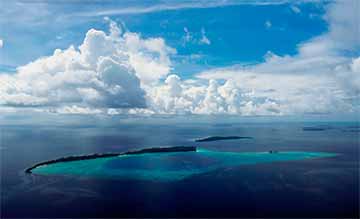PM Scott Morrison's Covid-19 lockdown exit plan has a big stumbling block
By David Speers quoted by Radio New Zealand.
After being pummelled for months over the vaccine "stroll-out" and wearing at least some of the blame for never-ending lockdowns, it's understandable the Prime Minister has grabbed a torch from the Doherty Institute to lead the nation "out of the cave".
The only problem is, not all Australians are in a cave.
The nation is currently divided between the locked-down and the free. The locked-down desperately crave an end to the grinding restrictions and line up for vaccination. Those living in freedom are quite happy with their zero Covid-19 situation and lag the rest of the nation on rolling up their sleeves for a jab.
Morrison, however, has chosen his course. It's the course of ending lockdowns once vaccination targets are met, reopening state borders and "living with" the Delta variant.
For the Prime Minister, it's been quite a journey. Since the arrival of Delta, he's has gone from praising Gladys Berejiklian for resisting lockdowns to embracing the need for hard lockdowns. Only weeks ago, the Delta strain represented danger and uncertainty.
Now Morrison is certain once more. Certain that despite the record numbers in NSW edging towards 1,000 cases a day, it's safe to end mass lockdowns once 70 percent or 80 percent of the adult population is vaccinated.
The Prime Minister is convinced by experts at the Doherty Institute, motivated by shifting voter sentiment (at least in the lockdown states) and encouraged by his temporary housemate at The Lodge, Josh Frydenberg.
It was the Treasurer who began to push back at nervous states, threatening to turn off the tap of financial support. Morrison backed this in, armed with updated advice from Doherty showing a high caseload would only mean an earlier peak in infections and hospitalisations, not a higher peak.
The biggest uncertainty
It's wrong, however, to pretend this will somehow be a risk-free step to end lockdowns once vaccination thresholds are met. It's less like stepping out of a cave and more like diving into the surf and hoping not too many are caught in the rip.
3AW's Neil Mitchell put it bluntly this week when he told the Prime Minister it was "a punt that could, if it goes wrong, cost 30,000 lives". Unsurprisingly, Morrison disagreed.
The biggest uncertainty in the plan is whether contact tracers can keep up with case numbers so high. On Wednesday NSW had a record 919 daily cases. The "source of infection" for 741 of those remained under investigation. The tracers are already struggling.
The Doherty Institute highlights this risk by noting "maintaining a rapid and highly effective TTIQ (test, trace, isolate and quarantine) response capacity is critical for ongoing epidemic control". Premiers and chief ministers will seek assurances on this at Friday's National Cabinet meeting. They also want more details on how high case numbers will impact unvaccinated children.
The Prime Minister is confident that despite "a bit of noise" this week, support for the plan will hold. He likes to point out leaders have already agreed to the plan three times, calling it a "compact with the Australian people".
That doesn't mean premiers are necessarily bound to it or particularly care about the views of voters outside their own jurisdiction. They will continue to prioritise the interests of their own state (and, therefore, their own political interests).
Western Australia's Mark McGowan and Queensland's Annastacia Palaszczuk have been rewarded by voters during this pandemic for keeping the virus out. Both states are currently enjoying freedoms other can only dream of. Cafes, pubs and stadiums are open.
Any move to relax border restrictions and willingly let Covid-19 in, even when 80 percent of adults are vaccinated, will take political courage.
The politics in lockdown states are different
Frydenberg and Morrison both argue it's "absurd" for any state or territory to think they can keep out the Delta strain forever. That doesn't mean letting Covid-19 into currently virus-free states will be a simple step. These premiers must ensure their contact tracers, hospitals and, indeed, electorates are ready to take the plunge
In the lockdown states, the politics are completely different. There is overwhelming support for a pathway to freedom. The lockdowns are getting harder not easier to survive the longer they drag on.
Daily vaccination rates in NSW and Victoria have surged to some of the highest in the world in per capita terms. The Prime Minister is likely on a winner in these states by presenting as the champion of hope, determined to end the stay-at-home "Groundhog Day".
It's worth remembering the raw electoral math here, too. More than half the seats in the House of Representatives are in NSW and Victoria. These two states will decide the outcome of the election.
There's been nothing subtle about the politics this week. Nearly every Dorothy Dixer to the government in Question Time has referenced the "re-opening plan". Ministers have lined up to hail its virtue.
At every opportunity Morrison has accused Anthony Albanese of opposing the plan and therefore the re-opening of the fatigued lockdown states.
The Labor leader began the week questioning the safety of ending lockdowns with such high numbers. By Wednesday he confirmed his support for the plan and returned his focus to vaccine and quarantine failures.
Unlike Albanese, McGowan and Palaszczuk don't have to worry about frustrated voters in NSW and Victoria. The political mood in those states won't influence their thinking. They will make their own judgements and have made a virtue throughout the pandemic of staring down a Prime Minister who wants them to open borders.
As yet there's no modelling to show whether the politics around keeping the virus out of these Covid-free states will shift, even when vaccination targets are hit.
*David Speers is the host of Insiders, which airs on ABC TV at 9am on Sunday or on iview.
SOURCES ABC and RADIO NEW ZEALAND.
Yours sincerely
Frank Short


